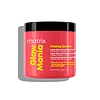What's inside
What's inside
 Key Ingredients
Key Ingredients

 Benefits
Benefits

 Concerns
Concerns

 Ingredients Side-by-side
Ingredients Side-by-side

Water
Skin ConditioningCetearyl Alcohol
EmollientStearamidopropyl Dimethylamine
EmulsifyingIsopropyl Myristate
EmollientCetyl Esters
EmollientHelianthus Annuus Seed Oil
EmollientButyrospermum Parkii Butter
Skin ConditioningParfum
MaskingTartaric Acid
BufferingBenzyl Alcohol
PerfumingCaprylyl Glycol
EmollientSalicylic Acid
MaskingLimonene
PerfumingRosa Canina Seed Oil
EmollientTocopherol
AntioxidantLinalool
PerfumingGlycolic Acid
BufferingHexyl Cinnamal
PerfumingCitric Acid
BufferingWater, Cetearyl Alcohol, Stearamidopropyl Dimethylamine, Isopropyl Myristate, Cetyl Esters, Helianthus Annuus Seed Oil, Butyrospermum Parkii Butter, Parfum, Tartaric Acid, Benzyl Alcohol, Caprylyl Glycol, Salicylic Acid, Limonene, Rosa Canina Seed Oil, Tocopherol, Linalool, Glycolic Acid, Hexyl Cinnamal, Citric Acid
Water
Skin ConditioningStearyl Alcohol
EmollientIsopropyl Palmitate
EmollientCetyl Alcohol
EmollientStearamidopropyl Dimethylamine
EmulsifyingDicetyldimonium Chloride
EmulsifyingAzadirachta Indica Seed Oil
Skin ConditioningHelianthus Annuus Seed Oil
EmollientArgania Spinosa Kernel Oil
EmollientHydrolyzed Adansonia Digitata Seed Extract
Pleiogynium Timoriense Fruit Extract
Skin ConditioningPodocarpus Elatus Fruit Extract
Skin ConditioningTerminalia Ferdinandiana Fruit Extract
AntioxidantHydrolyzed Quinoa
Skin ConditioningHydrolyzed Vegetable Protein
Skin ConditioningGlycerin
HumectantBehentrimonium Chloride
PreservativePropanediol
SolventArachidyl Alcohol
EmollientTocopheryl Acetate
AntioxidantButylene Glycol
HumectantEthylhexylglycerin
Skin ConditioningPhenoxyethanol
PreservativeParfum
MaskingWater, Stearyl Alcohol, Isopropyl Palmitate, Cetyl Alcohol, Stearamidopropyl Dimethylamine, Dicetyldimonium Chloride, Azadirachta Indica Seed Oil, Helianthus Annuus Seed Oil, Argania Spinosa Kernel Oil, Hydrolyzed Adansonia Digitata Seed Extract, Pleiogynium Timoriense Fruit Extract, Podocarpus Elatus Fruit Extract, Terminalia Ferdinandiana Fruit Extract, Hydrolyzed Quinoa, Hydrolyzed Vegetable Protein, Glycerin, Behentrimonium Chloride, Propanediol, Arachidyl Alcohol, Tocopheryl Acetate, Butylene Glycol, Ethylhexylglycerin, Phenoxyethanol, Parfum
 Reviews
Reviews

Ingredients Explained
These ingredients are found in both products.
Ingredients higher up in an ingredient list are typically present in a larger amount.
Helianthus Annuus Seed Oil is the oil derived from the seeds of a Sunflower. Sunflower seed oil is non-fragrant. It is an emollient, meaning it helps to soften the skin.
Sunflower seed oil contains many fatty acids. The fatty acids found in sunflower seeds include (from highest amount to least): linoleic acid, myristic acid, palmitic acid, stearic acid, arachidic acid, oleic acid, and linolenic acid.
These fatty acids help the skin create ceramides. Ceramides play a role in repairing the skin barrier.
Helianthus Annuus Seed Oil helps moisturize the skin. This in turn helps the skin look more rejuvenated and smoother.
Sunflowers are rich in vitamin E.
Historians believe Indigenous cultures of North America domesticated sunflowers before corn. Thus they relied on sunflower oil for a variety of uses. One such use is moisturizing skin and hair.
Sunflower seed oil may not be fungal acne safe. We recommend speaking with a professional if you have any concerns.
Learn more about Helianthus Annuus Seed OilParfum is a catch-all term for an ingredient or more that is used to give a scent to products.
Also called "fragrance", this ingredient can be a blend of hundreds of chemicals or plant oils. This means every product with "fragrance" or "parfum" in the ingredients list is a different mixture.
For instance, Habanolide is a proprietary trade name for a specific aroma chemical. When used as a fragrance ingredient in cosmetics, most aroma chemicals fall under the broad labeling category of “FRAGRANCE” or “PARFUM” according to EU and US regulations.
The term 'parfum' or 'fragrance' is not regulated in many countries. In many cases, it is up to the brand to define this term.
For instance, many brands choose to label themselves as "fragrance-free" because they are not using synthetic fragrances. However, their products may still contain ingredients such as essential oils that are considered a fragrance by INCI standards.
One example is Calendula flower extract. Calendula is an essential oil that still imparts a scent or 'fragrance'.
Depending on the blend, the ingredients in the mixture can cause allergies and sensitivities on the skin. Some ingredients that are known EU allergens include linalool and citronellol.
Parfum can also be used to mask or cover an unpleasant scent.
The bottom line is: not all fragrances/parfum/ingredients are created equally. If you are worried about fragrances, we recommend taking a closer look at an ingredient. And of course, we always recommend speaking with a professional.
Learn more about ParfumWe don't have a description for Stearamidopropyl Dimethylamine yet.
Water. It's the most common cosmetic ingredient of all. You'll usually see it at the top of ingredient lists, meaning that it makes up the largest part of the product.
So why is it so popular? Water most often acts as a solvent - this means that it helps dissolve other ingredients into the formulation.
You'll also recognize water as that liquid we all need to stay alive. If you see this, drink a glass of water. Stay hydrated!
Learn more about Water